Program Information
Quantitative Comparison of Two Prompt-Gamma Image Reconstruction Algorithms Using Compton Camera Detection Systems
I.I Valencia Lozano1*, G Dedes1 , DS Mackin2 , A Zoglauer3 , E Draeger4 , H Chen4 , S Beddar2 , S Aldawood1,5 , S Liprandi1 , A Miani1,6 , M Mayerhofer1,7 , P.G Thirolf1 , JC Polf4 , K Parodi1 , (1) Ludwig-Maximilians-Universitaet Muenchen, Garching B. Muenchen, Bavaria, (2) MD Anderson Cancer Center, Houston, TX, (3) UC Berkeley Space Sciences Laboratory, Berkeley, California, (4) University of Maryland School of Medicine, Baltimore, MD, (5) King Saud University, Riyadh, Riyadh, (6) Universita degli Studi di Milano, Milan, Lombardy, (7) Universitaet Hamburg, Hamburg, Hamburg
Presentations
SU-K-FS4-7 (Sunday, July 30, 2017) 4:00 PM - 6:00 PM Room: Four Seasons 4
Purpose: To compare the Prompt Gamma (PG) distributions reconstructed by a List-Mode Maximum-Likelihood Expectation-Maximization (LM-MLEM) and a Stochastic Origin Ensemble (SOE) algorithm, exploiting experimental and simulated data from two different Compton Camera (CC) detector systems.
Methods: The PG emission during the irradiation of a water phantom with a proton pencil beam of 150 MeV was measured using a pre-clinical CC detector system (CC-1) optimized for gamma tracking. The same irradiation was simulated in Geant4 for a prototype CC (CC-2) capable of electron tracking. Images were reconstructed following comparable input parameters for LM-MLEM and SOE. One-dimensional profiles were extracted from the obtained two-dimensional PG distributions and compared with the known depth-dose curve. The proton beam range was defined by the position of the distal 90% dose fall-off (Rᴰ), which was shown to be well correlated with the distal 60% (or 65%) PG fall-off (Rᴾᴳ).
Results: For the experimental data measured by CC-1, both reconstruction algorithms displayed comparable performance for the two-dimensional image reconstruction. In both the experimental and the simulated irradiation, the PG fall-off was accurately correlated with the measured distal edge depth-dose curve. The difference between Rᴰ and Rᴾᴳ was not exceeding 1.5 mm for the experimental data of CC-1. In the simulation of CC-2, the range agreement was below 1 mm and around 2 mm for LM-MLEM and SOE, respectively.
Conclusion: The comparison of two different CC systems and reconstruction algorithms quantitatively underlines a consistent correlation of the obtained PG distribution and the proton beam range with an agreement better than 2 mm. This study provides a framework for the evaluation of the range monitoring capabilities of different approaches for PG imaging. Further studies using more complex irradiation scenarios and heterogeneous phantoms will be outlined and discussed.
Funding Support, Disclosures, and Conflict of Interest: This work is supported by the International Max Planck Research School of Advanced Photon Science (IMPRS-APS), by the DFG Cluster of Excellence MAP (Munich-Centre for Advanced Photonics) and by King Saud University.
Contact Email:
